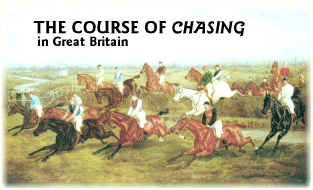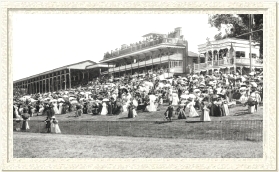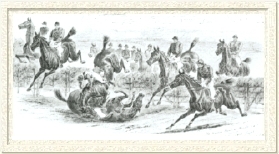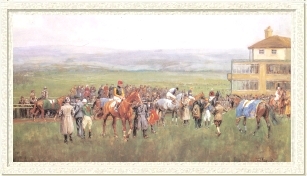|
|
Steeplechasing in Great Britain
 |
 | |
| |
By Paul Davies for Thoroughbred Heritage. ©Paul Davies, 2006. Paul Davies publishes The Complete Record, a regular newsletter that offers in-depth coverage of current steeplechasing and highly detailed information regarding the history of current and past races, horses, jockeys, trainers and owners. Past booklets, rich in detail, are available by contacting The Complete Record.
Left: Grand National of 1885
| | | |
According to the Ruff's Guide to the Turf in 1861 little more than 300 jumps
races were run in Britain.* By 1869 the number had increased significantly
to more than 700. The annual tally has continued to rise ever since, and
today around 3,000 races are held under National Hunt rules each year. In
addition, more than a thousand races are run at point-to-point meetings,
providing an important nursery for future jumping stars as well as being a
useful way of prolonging the careers of veterans.
These figures suggest that jump racing has enjoyed a steady rise in status.
This is not the case: although the total number of races staged has grown
without interruption, the course of jump racing history has been far from
smooth.
The absence of a governing body and a unified set of rules until the sport
was relatively well-developed led to widespread corruption. Flat racing
purists had little time for the new sport, even though many were committed
huntsmen. Indeed, the hunting fraternity failed to warm to jumping,
believing the new venture a contrivance which undermined the quality of the
horses available for the hunting field. In contrast, racing over timber
obstacles (hurdling) was tolerated as it made no attempt to replicate the
conditions encountered during a hunt. Curiously, the results of hurdling
events were recorded alongside those of Flat races in the Racing Calendar,
while steeplechases were completely overlooked.
Aintree's Grand National, first run in 1836, generated wide interest, but attempts to introduce other prestigious steeplechases were largely doomed to
failure. Typically, these races were organised by hotel-keepers for
financial motives. Apart from the Cheltenham Grand Annual Steeplechase, a
race which is still run to this day as part of the Cheltenham Festival, few
races survived more than a few years. There was no structure to the season
and races were often organised to coincide with local fairs and festivals.
It was not unknown for two neighbouring courses to stage meetings on the
same day, resulting in small fields and uncompetitive sport. Corruption was
endemic. The press, who were generally hostile to jump racing, revelled in
tales of wrong-doing amongst the crowds. Incidents of brawling, pugilism,
cock-fighting, drunkenness, prostitution, illegal gambling, welshing
(bookmakers failing to honour wining bets), and pick-pocketing were
commonplace, but, of course, most of these problems were not restricted to
race meetings.
An army of racing prohibitionists, led by churchmen, starchy council
officials, temperance campaigners and a puritanical press pushed many of the
livelier race meetings into extinction. Cheltenham, for instance, which
had strong links with the sport from its earliest days, disappeared from the
fixture list, thanks mainly to the efforts of the fearsome Reverend Close,
who claimed: "The Heathen festivals of Venus and Bacchus are exceeded on the
raceground."
Sandown - The First Enclosed Course
Other courses survived, but only on the promise of good
behaviour. The solution to the problem of rowdiness came with the
introduction of fully enclosed courses. Turnstiles and entrance fees helped
to keep the more unruly elements away from the racecourse, and at the same
time provided invaluable revenue. The first fully enclosed course was
Sandown, which opened in 1875. Well-appointed, and with an efficient rail
system to the capital and beyond, Sandown was an immediate success. Prize
money was high, and with a programme that incorporated Flat and jumps, the
course was able to race throughout the year. |

Sandown in the 1890s

A Sandown race in 1885 | |
Sandown owed its existence to a sequence of events that began with a
Monmouthshire doctor, Fothergill Rowlands, establishing a steeplechase in
1859. Rowlands, who was nicknamed "Fogo," had sacrificed a career in
medicine in favour of horse racing. A leading amateur jockey and trainer,
Rowlands was concerned that the quality of animals running in steeplechases
was in decline. Many were failed Flat horses. To accommodate them, courses
were reducing the size of the fences to such an extent that jumping ability
was less of an asset than speed. As a consequence, the old-style hunter was
starting to disappear from the sport.
Rowlands wanted to bring together the steeplechasing, hunting and farming
communities. To do so he introduced a race that would spearhead an annual
carnival of jump racing, entitled The National Hunt Steeplechase.
The race was open only to maidens, that is horses
without a win to their names. All entrants were to be fully fledged hunters
and only amateur jockeys were eligible to ride. To promote the sport,
Rowlands' new race was to be held at a different venue each year. He also
wanted it to be staged over courses made up of true hunting ground, with
live hedges, banks and brooks. In its early years the race met with varying
degrees of success, but a series of controversies dogged the event. |
As a
result of these and many other bitterly contested disputes, the Jockey Club
finally lifted its head from the sand and acknowledged the existence of
jumping by establishing a National Hunt Committee in 1865.
The National Hunt Committee Established
Over time the committee started tackling the many problems blighting the
sport. A set of governing rules were introduced, the powers of local and
external stewards were identified and attempts were made to standardize
fence size and the number of obstacles required per mile. In 1877 Thomas
Pickernell, a retired jockey with three Grand National wins to his credit,
was appointed the first Inspector of Courses.
One of the NH Committee's jobs was to select the course for the annual
National Hunt Steeplechase. By 1880, when the race was staged at Aintree, it
was clear that the initial objective of the race -- to promote the sport far
and wide -- had been jettisoned in favour of the course offering the highest
tender. And, as time went on, the highest bidder was inevitably one of the
new enclosed courses. It is partly as a result of this that hunts started
staging their own race meetings (point-to-points). |

Cheshire hunt meet in 1890 |
The pattern of the jumping year in the 1880s is worth recording. The season
ran from January to December, with a break in June and July. The vast bulk
of racing took place between March and May, with the Easter and Whitsun
holidays being particularly hectic times. Prize money was low in comparison
with racing on the Flat, but, ironically, it was to fall much lower in real
terms during the early twentieth century. The Grand National towered above everything. It offered the largest prize and was the most coveted race of
the year. The enclosed courses were able to race more often and were also
in a position to offer better prize-money.
Hurdle Racing Popularized
Racing over hurdles enjoyed huge popularity in the 1870s and 80s. The most
important race was the Grand International Hurdle, run at Croydon, until that
course was forced to close in 1890, and later at Gatwick. With the exception
of the Grand National, the Grand International was the only jumps race that
attracted any great betting interest. Entries were announced in January and
from then, until the race was run in March, the prices of the leading
candidates would be noted in the sporting papers, together with any
significant wagers. Usually, the Grand International attracted a decent
field, sometimes including recruits from the Flat or a Grand National
candidate having a run over hurdles. The Grand International was not the
only hurdle race with an attractive prize fund. In 1885, for instance, eight
of the top ten prizes over jumps were run over hurdles.
As well as steeplechases and hurdles, most cards featured Hunters Flat
Races, which provided an introduction to the sport for young horses and
jockeys. These races, which continued throughout the summer months, remained
popular in the 1890s. In the twentieth century they were run as National
Hunt Flat Races, but they disappeared prior to World War Two. It wasn't
until 1978 that they were re-introduced in Britain. They remain unpopular
with some racegoers and punters, but continue to play an important
educational role.
During the 1870s a challenger to the Grand National emerged. In 1874 the
Bristol Royal Chase offered a total prize fund of £1,805, only £100 short of
the Grand National. However, subsequent renewals were much less generously
endowed, and by 1888 Bristol had fallen by the wayside.
Big Races in the late 19th Century
A much more serious rival to the Grand National appeared in 1884. The
Lancashire Chase, which was run at Manchester on Easter Monday, began life
in a modest way. The first renewal, which attracted eight runners, offered
£500 to the winner, compared to the £1035 won by the Grand National victor,
Voluptuary. However, as the race became established, prize money increased
until in 1893 it briefly surpassed the National as the season's most
valuable event. The Lancashire Chase never quite toppled the National, in
part due to the fact that it was run on a Bank Holiday where it was in
competition with many other race meetings and many counter-attractions.
Also, the Manchester course couldn't begin to compete with the spectacular
Aintree fences. Nevertheless the Lancashire Chase remained a valuable prize
well into the twentieth century, offering a handsome consolation for horses
beaten at Aintree. The Lancashire Chase continued to be run in 1963, finally
disappearing when Manchester racecourse closed down.
Another big race during the late nineteenth century was the Champion Chase.
This was traditionally run on the final day of Aintree's Grand National
meeting (the Grand National itself being staged on the second day, a
Friday). Most chases at this time, with the exception of the National Hunt
Chase, were run as handicaps, but the Champion Chase was a weight-for-age
contest. It was run over two furlongs shy of three miles and featured all
the forbidding National fences. The Champion Chase was won by many of the
top chasers of the day (including Gamecock who, uniquely, in 1887 won the
Grand National and Champion Chase on successive days) but the race was never
popular, partly as it was erroneously seen as a race for Grand National
failures. The Champion Chase survived the Second World War and was run for
the last time in 1950.
Aintree also staged an autumn meeting that included a number of races over
the National fences. The most important of these was the Grand Sefton, which remained a feature of the jumping calendar for one hundred years from 1865.
The Grand Sefton was run over three miles of the National course, and was
the natural first port of call for numerous Grand National aspirants.
The Rise of Cheltenham
At the turn of the twentieth century, the Grand National dominated National Hunt racing to the extent that little else seemed to matter. Yet the NH
Committee's decision to give the 1902 National Hunt Festival to Cheltenham
would eventually lead to a seismic shift in the nature of jump racing.
Cheltenham's initial tenure as host to the National Hunt Festival lasted
only two years, before the race moved to Warwick in 1904. But Cheltenham was
determined to win the right to stage the race again and after a seven year
gap, the National Hunt Chase returned to Prestbury Park in 1911. And there
it stayed. The notion of moving the meeting from course to course was
quickly forgotten, and Cheltenham set about re-establishing itself as the
home of jumping. Alongside the National Hunt Chase, several new and
extremely valuable races were introduced including: the National Hunt
Handicap Chase, an important Grand National trial; the Gloucestershire
Hurdle for novices; the County Handicap Hurdle; and the revived Grand Annual
Chase.
During the 1920s, under innovative clerk of the course Frederick Cathcart,
Cheltenham went from strength to strength. In 1923 the Festival was extended
from two to three days. Then, the following year, a new race was added to
the programme. Despite its grandiose title, The Cheltenham Gold Cup was not among the most important races of the meeting. But within a few years it had
captured the imagination of the racing public, thanks to the exploits of
two-time winner Easter Hero and the remarkable Golden Miller, owned by the
wealthy but eccentric Dorothy Paget. Golden Miller won the Gold Cup on five
successive occasions and was only denied a sixth win in 1937 when the race
was lost to bad weather. He did return in 1938 in the twilight of his
career, but was beaten into second by Morse Code. |

Cheltenham paddocks in mid-20th Century | |
Three years after launching the Gold Cup, Cheltenham introduced a
weight-for-age hurdling championship, the Champion Hurdle. Until this point all hurdle races of
any importance had been handicaps. The races early years were typified by
small fields, but by the end of the 1930s, it was firmly established as the
premier event in the hurdling division, surpassing Sandown's Imperial Cup, a
valuable handicap launched in 1909, and Aintree's Liverpool Hurdle, which
suffered a long painful decline before disappearing from the calendar in the
mid 1970s. |
Apart from the Cheltenham Festival and the Grand National meeting, there
were few highlights to the season, which, after 1925, ran from August to June.
There was the Aintree Autumn Meeting, a couple of National trials in the
spring, and the Grand Military Meeting, the highlights of which were the
Grand Military Gold Cup, restricted to horses owned and ridden by members of
the armed forces, and the Imperial Cup. Scotland and Wales had their own Grand Nationals, run respectively at Bogside and Cardiff, but these were
usually parochial affairs, with relatively modest prize funds.
Grand National Threatened
During the 1950s Aintree's fortunes began to suffer. Shabby and run down,
after years of military use, a few coats of paint could not disguise the
fact that the stands and enclosures were slowly falling apart. In fairness,
the owners of the course, the Topham family, did invest money, building a
new steeplechase course with scaled down versions of the National fences.
This new track was named after the popular amateur jockey Lord Mildmay, who
had helped in the design process. The replica National fences were not a
success and were eventually replaced by conventional park fences. The
Tophams also funded the building of a motor racing circuit on the inside of
the National course. In the short term this proved successful, and on several
occasions Aintree hosted the British Grand Prix.
However, despite the huge outlay on these projects, the Tophams were unable
to transform Aintree's flagging fortunes. The appeal of the Grand National
remained for the racing public, but year by year the standard of the race
dropped. Gone were the days when the Gold Cup winner would automatically
take his place in the line-up, and a sequence of fatalities in the 1950s
damaged the race's reputation even further. By the early sixties Mirabel
Topham had had enough. She tried to sell the course, sparking a long running
drama over the future of the National. For many years it appeared as though
the race was doomed, although a transfer to another course such as Doncaster
or Cheltenham was considered.**
Aintree's decline was in stark contrast to the ever increasing popularity of
the Cheltenham Festival. By the 1960s, the meeting was universally
acknowledged as the most important in the calendar. The Gold Cup and the
Champion Hurdle were now the undisputed championship races for chasers and
hurdlers, and in 1960 a two mile championship chase was introduced. Now run
as the Queen Mother Champion Chase, this race is, for many purists, the
highlight of the Festival, invariably providing a thrilling show of jumping
at speed. The Cheltenham Festival also features a number of championship
races for novice chasers and hurdlers, a champion Flat Race, and a range of
ultra-competitive handicaps.
An important element of the Cheltenham Festival mix is the annual Irish
invasion. Each March thousands of Irish racing folk descend on the Cotswolds,
adding a friendly and convivial note to proceedings. Irish-trained horses
have enjoyed many periods of dominance, winning more than 200 races at the
meeting. In 2005, Irish-trained horses won the Gold Cup, the Champion Hurdle
and the Queen Mother Champion Chase as well as the two most important races
away from Cheltenham: Kempton's King George VI Chase and Aintree's Grand
National.
New Life for Jumps Racing
The popularity that jump racing now enjoys in Britain and Ireland owes much
to two inter-related developments of the mid-twentieth century: television
and sponsorship. Sandown was the first course to host televised racing in
1948. Within a few years racing became a regular and highly popular feature
of television. Racecourse attendances were hit by TV coverage, but
advertisers soon recognised the potential for relatively cheap airtime by
sponsoring televised races. Not only would their products be mentioned many
times during the course of a broadcast, but strategically placed advertising
boards around the course provided further coverage.
Steeplechasing proved to be the perfect medium for advertisers. The races
often lasted for seven and eight minutes and were staged during the winter
when audience figures were higher. Sandown staged the first sponsored race,
the Whitbread Gold Cup in April 1957. In November of the same year, the
Hennessy Cognac Gold Cup was run for the first time at Cheltenham (the race
moved to its present home, Newbury, in 1960). Within a few years valuable
sponsored races were a feature of most Saturday afternoons, from November to
April. As a consequence the National Hunt season could at last be said to
have a balanced structure, with a series of valuable prizes leading up to a
grand finale in March and April. And, for the first time, horses could earn
significant sums of money for their owners without ever having to chance the
perils of the Grand National.
Today jump racing in Britain appears in good heart, although many fear that
the abolition of hunting with dogs may jeopardise one of jumpings
traditional nurseries, the point-to-point. It is too early to say whether or
not these fears will be realised, although the early indications are that
point-to-point racing is flourishing, despite (or even because of) the
hunting ban.
There is also a concern that old fashioned jumping stock is fast
disappearing in favour of horses bred from Flat lines. Stamina, jumping
technique and durability have been sacrificed at the altar of speed,
resulting in more frequent injury absences, shortened careers and, in the
worse case scenario, early death, all to often seen on the racetrack.
Many of the present generation of chasers and hurdlers are lightly raced,
taking in a couple of quiet races prior to their Cheltenham Festival target.
Then, if there is fuel left in the tank, a trip to Aintree's restyled Grand
National meeting is the norm. The consequence of this selectivity is that
many valuable races between November and February are failing to attract
fields of the highest quality. In response the British Horseracing Board has
introduced an Order of Merit scheme, which is effectively a reward scheme
for horses who keep busy throughout the season. The Order of Merit prize is
not insignificant, nor is the £1 million on offer to any horse that wins
chasing's triple-crown: the Betfair Chase, a race run for the first time at
Haydock in November 2005, the King George VI Chase, run at Kempton each
Boxing Day, and the Cheltenham Gold Cup in March.
Whether the Order of Merit and the Betfair Million will have the same effect
as the introduction of the National Hunt Chase did almost a century and a
half ago, we will have to wait and see.

Notes
* This figure is certainly an underestimate as a number of meetings,
including the well-established Croydon were omitted.
** Against all the odds, Aintree and the Grand National survived. Dropping
Flat racing in 1976, the course now stages a three-day spring meeting second
only to the Cheltenham Festival. Happily, in 1992, the Autumn Meeting was
revived.
|
|

